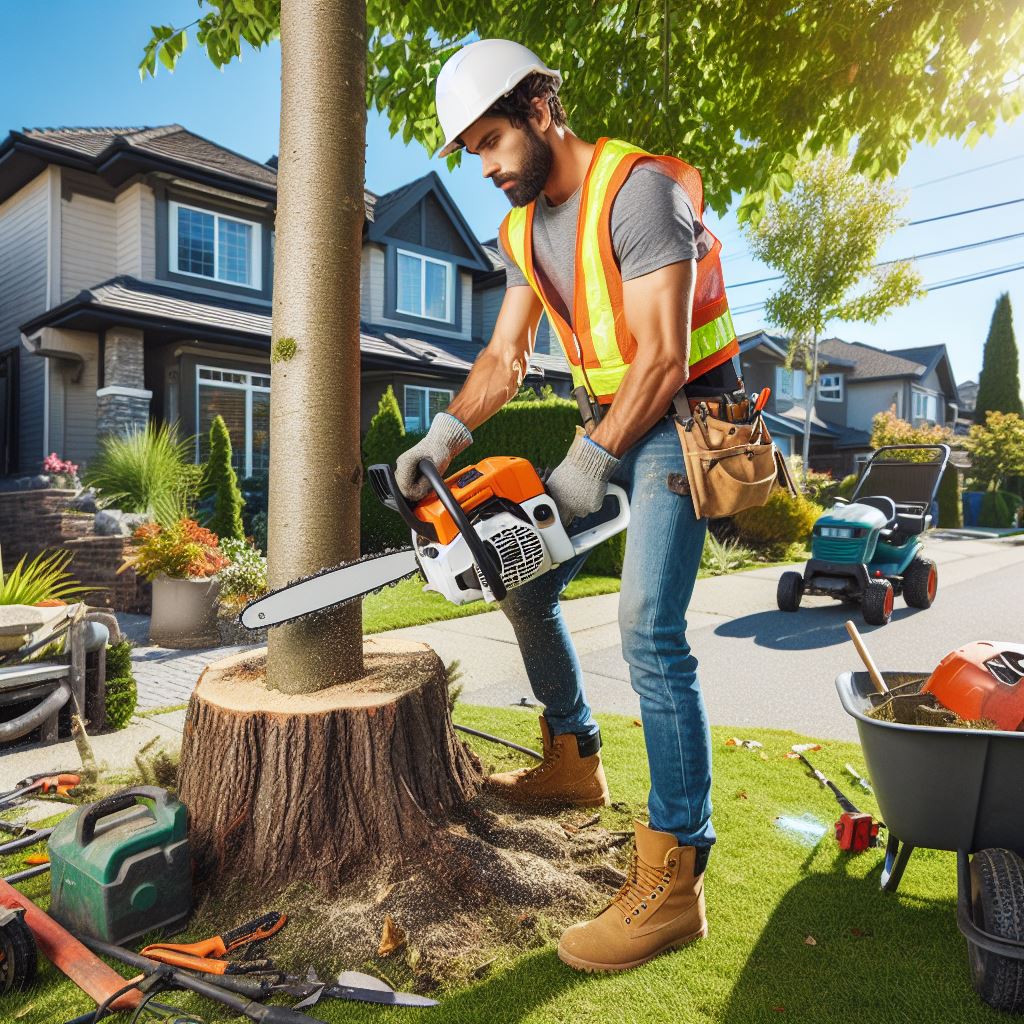Introduction
Importance of landscaping
Landscaping is an essential aspect of home improvement.
It enhances the beauty of your surroundings and creates a peaceful environment.
In this blog post, we will provide you with a comprehensive guide on landscaping.
We will cover everything from the basics of landscaping to advanced techniques.
Our goal is to help you create a beautiful outdoor space that you can enjoy with your family and friends.
Landscaping is not just about making your yard look pretty.
It’s about creating a space that you can enjoy and that reflects your personality.
A well-landscaped yard can increase the value of your home and make it more attractive to potential buyers.
It can also help to reduce your energy bills by providing shade in the summer and insulation in the winter.
Overview of the blog post
In this blog post, we will cover the importance of landscaping and how it can benefit you and your home.
We will discuss the different types of landscaping, such as hardscaping and softscaping, and provide you with tips on how to choose the right plants for your garden.
We will also provide you with information on how to design a landscape that’s easy to maintain and that will look great all year round.
Our guide will cover everything from the basics of landscaping to advanced techniques.
We will provide you with step-by-step instructions on how to create a beautiful outdoor space that you can enjoy with your family and friends.
So, whether you’re a beginner or an experienced landscaper, this blog post is for you. Let’s get started!
Benefits of Landscaping
Landscaping offers numerous benefits for Canadians, ranging from aesthetic improvements to positive impacts on mental and emotional well-being.
Below are some advantages of landscaping:
Aesthetics and Curb Appeal
- Landscaping enhances the visual appeal of a property, creating a welcoming and pleasant atmosphere.
- Well-designed landscapes with beautiful plants, hardscapes, and outdoor features add charm and character to any property.
- The curb appeal of a landscaped property is often higher, making it more attractive to potential buyers or visitors.
Increased Property Value
- Landscaping has been proven to increase property values, providing a good return on investment.
- A well-maintained landscape can significantly boost the value of a home or commercial property.
- Mature trees, manicured lawns, and appealing outdoor spaces are among the key factors that contribute to higher property prices.
Environmental Benefits
- Landscaping helps to reduce soil erosion by retaining water and preventing runoff.
- Trees and plants absorb carbon dioxide and release oxygen, improving air quality and reducing pollution.
- Properly designed landscapes can also provide shade, reducing energy consumption by cooling buildings during hot summers.
- Well-placed trees and shrubs act as windbreaks, reducing energy use by cutting down on wind chill during winter months.
Mental and Emotional Well-being
- Surrounded by nature, such as trees, flowers, and green spaces, can have a positive impact on mental health.
- Landscaping offers a peaceful and calming environment, reducing stress and promoting relaxation.
- Being outdoors and engaging with nature has been linked to improved mood and increased happiness.
- Having a garden or green space can also provide opportunities for physical exercise and social interaction.
- Gardening and taking care of plants can give a sense of pride, achievement, and purpose, enhancing overall well-being.
In general, landscaping provides a wide range of benefits for Canadians.
It not only enhances the aesthetics and curb appeal of a property but also increases its value.
Moreover, landscaping contributes to environmental preservation and conservation, while positively impacting mental and emotional well-being.
Investing time and effort into landscaping can truly transform any property into a beautiful and inviting space.
Read: Seasonal Landscaping: Tips for Canadian Climates
Understanding the Canadian Climate
In order to create a successful and thriving landscape, it is crucial to understand the climate of your region.
Canada is a vast country with diverse weather patterns, so it is important to consider the specific needs of your area when planning your landscaping project.
Overview of different regions and climates in Canada
- Atlantic Provinces: This region experiences mild summers and cold winters with heavy snowfall. Coastal areas are prone to strong winds and salt spray.
- Central Canada: Summers are warm, while winters are cold with heavy snowfall. This region experiences significant temperature variations throughout the year.
- Prairie Provinces: Summers are hot and dry, while winters are cold with minimal snow. This region is also prone to strong winds.
- West Coast: This region has mild, wet winters and cool, dry summers. It is known for its temperate rainforests.
- Northern Canada: This region has long, cold winters and short, cool summers. It experiences polar climates with permafrost.
Considerations for landscaping based on climate
- Temperature: Choose plant varieties that can tolerate the average low and high temperatures of your region.
- Precipitation: Consider the amount of rainfall or snowfall in your area and select plants that can thrive in those conditions.
- Wind: If you live in a windy area, choose plants that can withstand strong gusts and provide windbreaks to protect more delicate plants.
- Soil Composition: Understand the soil composition in your region and choose plants that are suited to it. Consider amending the soil if necessary.
- Sunlight Exposure: Different areas receive varying amounts of sunlight. Select plants that can thrive in the level of sunlight available in your region.
Choosing the right plants and trees for different regions
- Atlantic Provinces: Consider salt-tolerant plants like rugosa roses and junipers. Plant trees like sugar maples and white spruces.
- Central Canada: Choose hardy plants like coneflowers and sedums. Opt for trees like white birches and red maples.
- Prairie Provinces: Select drought-tolerant plants like lavender and yarrow. Plant trees like bur oaks and trembling aspens.
- West Coast: Opt for shade-loving plants like ferns and hostas. Choose trees like Douglas firs and western red cedars.
- Northern Canada: Consider plants like arctic poppies and moss campion that can withstand cold temperatures. Plant trees like black spruces and tamaracks.
By understanding the climate of your region and choosing the right plants and trees, you can create a beautiful and sustainable landscape that will thrive in the Canadian climate.
Unlock Your Career Potential
Visualize a clear path to success with our tailored Career Consulting service. Personalized insights in just 1-3 days.
Get StartedRead: Eco-Friendly Landscaping Tips in Canada
Planning Your Landscape Design
When it comes to designing your landscape, proper planning is crucial.
By assessing your space and needs, setting a budget, creating a layout, and including hardscape elements, you can ensure a successful landscaping project.
Assessing your space and needs
Before diving into any landscaping project, take the time to assess your space and identify your needs.
Consider factors such as the size of your yard, the existing vegetation, and any specific requirements you may have, like a garden area or a children’s play space.
Setting a budget
Determine how much you are willing to spend on your landscaping project.
Consider the cost of materials, labor, and any additional services you may require.
Setting a budget will prevent overspending and help you prioritize your design elements.
Creating a layout or blueprint
Once you have a clear understanding of your space and budget, it’s time to create a layout or blueprint.
This involves plotting the various elements you want to include in your design, such as flower beds, trees, shrubs, and other features.
A layout will provide you with a visual representation of your future landscape.
Including hardscape elements
Don’t forget to incorporate hardscape elements into your design.
Hardscapes are non-living features that can enhance the functionality and aesthetics of your landscape.
Consider adding patios, walkways, retaining walls, or even a pond or fountain.
These features can add dimension and interest to your outdoor space.
When planning your landscape design, be sure to consider these key factors.
Assess your space and needs, set a budget, create a layout or blueprint, and include hardscape elements to transform your yard into a beautiful and functional outdoor oasis.
This careful planning will ensure that your landscaping project is a success.
Benefits of Planning Your Landscape Design
- Efficient use of space: By carefully planning your landscape design, you can optimize the use of available space and ensure that every area serves a purpose.
- Increased property value: A well-designed landscape can significantly increase the value of your property. Potential buyers will be drawn to a visually appealing outdoor space.
- Improved curb appeal: A thoughtfully planned landscape will enhance the curb appeal of your home, making it more inviting and attractive.
- Personalized touch: Planning allows you to incorporate your personal preferences and design ideas into your landscape, making it a reflection of your unique style.
- Environmental considerations: Planning your design enables you to choose environmentally friendly options, such as native plants or water-efficient features.
- Ease of maintenance: With a well-planned landscape design, you can create low-maintenance areas that require minimal upkeep, saving you time and effort in the long run.
In essence, planning is essential when it comes to designing your landscape.
Assess your space and needs, set a budget, create a layout, and include hardscape elements to ensure a successful project.
By taking these steps, you can create a beautiful and functional outdoor space that adds value to your property and brings you joy for years to come.
Read: Top 10 Landscaping Tools Every Pro Needs
Planting Basics
Understanding soil types and conditions
- Conduct a soil test to determine the pH level and nutrient content of your soil.
- Different plants thrive in different soil types, such as sandy, clay, or loamy soil.
- Amend your soil accordingly by adding organic matter to improve drainage, fertility, and texture.
Selecting the right plants for your landscape
- Consider the local climate and growing conditions when selecting plants for your landscape.
- Choose plants that are suitable for your hardiness zone to ensure their survival.
- Research the mature size and growth habits of plants to ensure they don’t overcrowd your space.
- Consider the overall aesthetic and maintenance requirements of the plants you select.
Planting techniques and best practices
- Dig a hole that is wide and deep enough to accommodate the plant’s root system.
- Gently remove the plant from its container, loosen the roots, and place it in the hole.
- Backfill the hole with soil, making sure the plant is at the same level as it was in the container.
- Water the plant thoroughly after planting to settle the soil and provide moisture.
- Mulch around the plant to conserve moisture, suppress weeds, and regulate soil temperature.
Incorporating native plants for sustainability
- Native plants are adapted to local conditions, require less water, and are more resistant to pests and diseases.
- Planting native species helps support local wildlife, including birds, butterflies, and pollinators.
- Research native plants that are suitable for your region and incorporate them into your landscape design.
- Native plants also provide a sense of place and enhance the natural beauty of your surroundings.
Benefits of using native plants
- Reduced water usage: Native plants have evolved to withstand local climate conditions and require less watering.
- Increased biodiversity: Native plants provide food and habitat for native insects, birds, and other wildlife.
- Pest resistance: Native plants have developed natural defenses against local pests and diseases.
- Soil health: Native plants promote healthy soil by improving its structure and nutrient content.
- Lower maintenance: Once established, native plants generally require less maintenance compared to non-native plants.
Creating a sustainable landscape
- Choose a variety of plants with different bloom times and foliage for year-round interest.
- Use organic fertilizers and avoid chemical pesticides to promote a healthy ecosystem.
- Implement water-saving techniques like drip irrigation, rain barrels, and proper watering practices.
- Incorporate permeable surfaces, such as gravel or permeable pavers, to reduce stormwater runoff.
- Emphasize native plants in your landscape to support local ecosystems and conserve resources.
By following these planting basics and incorporating native plants, you can create a beautiful and sustainable landscape that thrives in Canadian conditions.
Remember to research and choose plants that are well-suited to your local climate and soil conditions.
Happy gardening!
Read: Starting Your Landscaping Business in Canada

Maintaining Your Landscape
In order to keep your landscape looking healthy and vibrant, it is important to regularly maintain it.
Here are some strategies and techniques to help you maintain your landscape:
Watering Strategies and Irrigation Systems
- Water your plants deeply and infrequently to encourage strong root growth.
- Use a drip irrigation system to deliver water directly to the roots of your plants.
- Install a rainwater harvesting system to collect and use rainwater for irrigation purposes.
Fertilization and Proper Soil Care
- Test your soil regularly to determine its nutrient levels and pH balance.
- Use organic fertilizers to provide essential nutrients to your plants.
- Apply mulch around your plants to retain moisture and prevent weed growth.
Pruning and Trimming Techniques for Trees and Shrubs
- Prune your trees and shrubs during the appropriate season to promote healthy growth.
- Remove any dead, diseased, or damaged branches to improve the overall appearance of your landscape.
- Trim shrubs to maintain their shape and prevent them from becoming overgrown.
Dealing with Pests and Common Landscaping Issues
- Identify and diagnose any pest problems early to prevent damage to your plants.
- Use natural pest control methods, such as introducing beneficial insects or using organic insecticides.
- Address common landscaping issues, such as weed control and drainage problems, promptly.
By following these strategies and techniques, you can ensure that your landscape remains healthy and beautiful throughout the year.
Regular maintenance will help your plants thrive and create an inviting outdoor space for you and your family to enjoy.
Landscaping Tips for Canadians
Considering seasonal changes
- Plan your landscape according to the specific seasonal changes that occur in your area.
- Choose plants that can withstand the harsh Canadian winters and thrive in the warmer months.
- Create a diverse mix of plants that bloom at different times throughout the year.
Winterizing your landscape
- Insulate your plants by applying a layer of mulch around their base.
- Wrap delicate shrubs and small trees with burlap to protect them from the cold.
- Install windbreaks such as fences or hedges to shield your landscaping from strong winds.
Using environmentally friendly practices
- Opt for native plants that are adapted to the local climate and require less water and maintenance.
- Avoid using chemical pesticides and fertilizers that can harm the environment and wildlife.
- Implement sustainable irrigation methods, such as drip irrigation or rainwater harvesting.
Working with professional landscapers, if needed
- Consider hiring professional landscapers to help with intricate design plans or large-scale projects.
- Research and hire reputable landscapers who have experience working in your area.
- Collaborate with the landscapers to ensure your vision is brought to life while following best practices.
In a nutshell, these landscaping tips for Canadians can help you create a beautiful and sustainable outdoor space.
By considering seasonal changes, winterizing your landscape, using environmentally friendly practices, and working with professionals when needed, you can achieve a stunning and low-maintenance landscape that thrives all year round.
Remember that a well-planned and maintained landscape not only enhances the aesthetic appeal of your property but also adds value to your home.
Conclusion
This blog post has provided a comprehensive guide to landscaping for Canadians.
We discussed important points, such as the importance of planning and designing, selecting suitable plants, proper maintenance, and sustainable practices.
With all this information at your disposal, it’s time to start your own landscaping projects.
Don’t be intimidated; take small steps and gradually expand your skills.
Remember, a well-maintained landscape offers numerous long-term benefits.
Apart from enhancing the beauty of your property, it can increase its value, improve air and water quality, and provide a welcoming environment for wildlife.
So, don’t hesitate any longer.
Put on your gardening gloves, grab your tools, and embark on your landscaping journey.
Transform your outdoor spaces into vibrant, functional, and eco-friendly havens that you and your family can enjoy for years to come.




